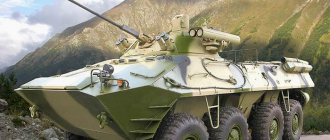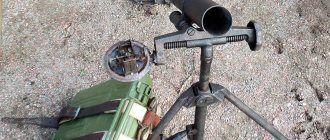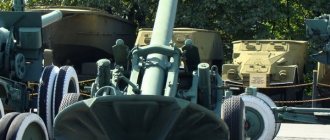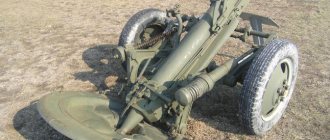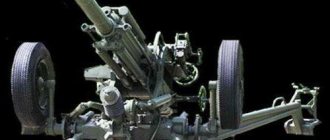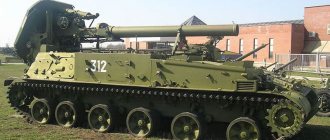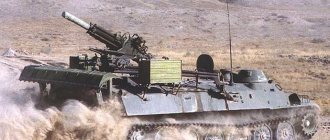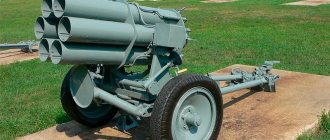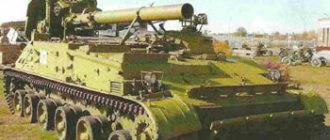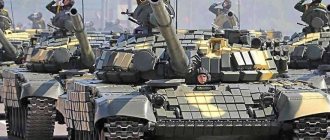5 156
Currently, the digitization of initially analog products makes it possible to unlock significantly higher potential in them. The Austrian arms manufacturer (Hirtenberger Defense Systems, HDS) followed this path. Its product, the 60 mm M6 mortar in the Commando version, received a new digital aiming system.
60 mm mortar M6 Commando
The design of the 60 mm M6 “Commando” mortar is quite simple. The weapon kit consists of a barrel with a supporting bottom plate and a corresponding set of ammunition. In the classic version, aiming is carried out by pointing the barrel at the target with your hand. The angle of the barrel and the number of charging rings on the mine determine the firing range. Effective and relatively quick target destruction is possible at a distance of up to 1500 m.
At ranges greater than 500 m, manually approximate barrel orientation becomes a source of error and significantly affects fire efficiency. Under conditions of increased stress (fatigue, enemy fire, increased heart rate due to physical exertion), both the required amount of ammunition and the time required to destroy the target increase.
Shooting from hand
Electronic sight GRAM
At the international defense technology exhibition DSEI 2017 (Defense and Security Equipment International), HDS representatives demonstrated their new development. This electronic guidance device (hereinafter referred to as the sight) received the designation GRAM (Grid Aiming Device, Russian - grid guidance device).
GRAM combines several position sensors to orient the barrel in space, a ballistic computer and a power supply. The total weight of the equipment does not exceed 900 g.
For ease of use in field conditions, the ballistic computer and power supply are mounted in the shoulder strap. The sensor unit folds for transportation and unfolds before firing. The sensors are attached to the barrel using a clamp. Compared to classic levels, they provide much more accurate lateral and vertical angles of the mortar barrel.
For sufficiently high shooting accuracy, the minimum distance between the barrel and the sensors should be 20 cm. In addition to calculating shooting parameters, the developed software provides a wireless interface for communication and integration of all elements of the sight.
GRAM kit
According to the developers, the use of new equipment significantly increases the accuracy of 60 mm mortar fire and reduces the time and amount of ammunition required to suppress a target. In addition, misses due to shooter error are eliminated and collateral damage is more likely to be reduced. The effective range of mortar fire is increased.
KBA-118
Produced by the State Enterprise “Design Bureau “Artillery Design”. It was first presented at the arms exhibition “Zbroya and Bezpeka-2013”. Its mass in combat position is 12.9 kg, firing range is 1430 meters.
Although the model was repeatedly demonstrated to the country's top military-political leadership, there is no data on its adoption.
MP-60
Modified 60 mm mortar - application tactics
As experts note, until now the main advantage of the special version of the M6 mortar was its quietness. At the same time, direct visibility of the target was required to fire. At the same time, both the mortar and the crew could be detected and hit by the enemy.
The new guidance system is believed to eliminate this danger. When firing, the shooter and weapon can remain in cover. According to the manufacturer, classic reconnaissance tools (binoculars, compass and map) or a more modern laser rangefinder are sufficient to use the new guidance system. The GRAM kit made the 60 mm mortar suitable for precision mounted fire.
Shooting from a closed position
Possible tactical episode
Included in an infantry platoon, a mortar crew is on the march or equipping a shelter for positioning on the ground. At this time, the sniper team assigned to guard discovered a potential threat on the flank.
Using his laser rangefinder and his own GPS device, the sniper determines the exact position of the enemy within a few seconds. At the same time, the sniper cannot unmask his position by opening fire, or the target is out of his reach. In this case, the sniper, by voice or via communication channels, transmits data about the enemy directly to the commander of the mortar crew.
Having received target designation, the crew commander gives orders to the mortarman to prepare the M6 “Commando” for firing. In those seconds while the mortarman carries out his command, the crew commander, using a ballistic computer, converts the target report into a command to fire. It calculates the direction angles and elevation of the barrel, the number of charging rings on the shot.
According to the manufacturer, errors when firing under appropriate operating conditions of the system and training of personnel are possible only due to external factors (for example, weather). Under ideal weather conditions (calm at all altitudes) and the use of radio data transmission, it will take two to three minutes from the request for mortar fire to hitting the target.
Ballistic computer
M-57
Developed in the 1950s in Yugoslavia based on the design of the American M3 mortar. After the collapse of Yugoslavia, production remained in Bosnia and Herzegovina, from where Ukraine, after 2015, began to buy mortars and mines for them. At least 50 units purchased. The total weight is 19.85 kg, the sight is NSB-3. The minimum firing range is 75 meters, the maximum is 2540 meters.
LM-60D and a Polish-made mine tube
Versatility and additional combat potential
According to experts, the 60 mm mortar from HDS demonstrates impressive versatility. The user himself determines whether he uses a classic mortar or a digital one with attached sighting equipment. The main functionality of the M6 “Commando” does not depend on this.
The developed ballistic computer allows you to integrate data on the flight of any 60 mm mortar ammunition. On the one hand, this increases the combat capabilities of previously produced mortars, and on the other, it guarantees the ability to fire with ammunition from third-party manufacturers.
New ammunition
In addition, Hirtenberger is seeking to increase the appeal of its products by offering a special 60mm shot with increased power. The product, with an impact on the target equivalent to the classic 60 mm high-explosive ammunition, has a weight of 30 percent less.
It is reported that the manufacturer, using its own ConFrag technology (controlled fragmentation), seeks to further optimize the impact of this ammunition on the target. If the same weight is maintained, the effect (mortality) should be more than 50 percent. Product certification was planned to be completed in 2017.
The potential of the system is demonstrated by the following example. Currently, the M6 Commando mortar crew carries about 30 kg of weight: a 60 mm mortar - 10 kg and 10 rounds of 1.79 kg. In the new combination, the total weight would be only 24 kg: mortar, sight and 10 shots of 1.25 kg.
In addition to weight reduction, the combat effectiveness of the weapon increases by 50 percent. The sources of growth are: a significant increase in shooting accuracy, an increased probability of hitting with the first shot, speed of fire and an increased lethal effect on the target. The crew can fire from cover, which ensures its survivability.
M6 Commando mortar crew
Mortars, mortar systems and mortar ammunition
Ongoing development of light mortars promises increased levels of accuracy and mobility for those using this powerful support weapon in urban environments, while heavier self-propelled variants are at the center of projects to reduce weight and recoil forces, Land Warfare International August reports.
In July 2013, BAE Systems achieved a major milestone in its XL59 program and successfully fired an 81mm mortar "low-sensitivity ammunition" at Qinetiq's Eskmeals range in the UK. They followed preliminary tests carried out a month earlier, where all projectiles flew along the expected trajectory over the entire temperature range from -46 to +71°C and at different charge masses.
The qualification program will begin in late 2013, with production and deliveries expected to begin in early 2015. The 81mm mortar is the subject of a number of projects to develop improved solutions for infantrymen.
In early 2012, BAE Systems and General Dynamics Ordnance and Tactical Systems (GDOTS) announced that they would jointly develop, demonstrate and produce an affordable version of the RCGM (Roll Controlled Guided Mortar) 81 mm high-precision mortar round.
| XM395 PGMM - guided high-explosive mines of 120 mm caliber XM395 PGMM. Photo: www.deagel.com |
The XM395 120mm high-precision mortar round has a circular probable deviation of less than 10 meters
Combat effectiveness
This solution uses the existing British L41 projectile and the American M734A1 fuze, incorporating GPS guidance and RCFC (Roll Controlled Fixed Canard) technology from GDOTS. According to BAE Systems, such a solution puts “a low-cost, high-precision indirect fire system into the hands of the soldier on the front line, dramatically increasing his combat effectiveness,” as well as increasing accuracy to deliver faster effective fire to the target.
The development culminated in 25 live firings with a British 81mm mortar at the Yuma training ground in the presence of representatives of the armies of Australia, Canada, Great Britain and the United States, as well as the Marine Corps. The firing showed that it is quite possible to create lighter mortars, for example, an 81-mm mortar weighing 4.5 kg can increase the mobility and accuracy of existing mortars.
The last decade has seen increased demand for more accurate and mobile mortar systems. The transfer of hostilities to cities in particular and the need to limit indirect losses in these conditions force the development of high-precision mortar weapons.
Most mortar systems are designed for use by infantry units, they must be lightweight and easily transportable, providing fire support in a variety of environmental conditions and delivering accurate overhead fire at ranges of 70 - 7000 meters or more. In the US military, mortars are standard equipment in all brigade combat team battalions, as well as in the US Special Operations Command.
“The U.S. Army uses mortar fire either to stop, suppress, and neutralize enemy forces or in contact with allied forces to illuminate the battlefield, provide a screen, or prevent hostile action against U.S. and allied forces,” said a Picatinny Arsenal spokesman. - During Operation Iraqi Freedom, mortars did not play a major role, since the rules of engagement limited their use; at that time it was a weapon for striking areas and mortars were not fired in Baghdad, in particular due to the problem of collateral damage.”
Extensive needs
Since then, the US military has submitted a number of operational requirements statements, including a request for a 120mm precision mortar round. The Accelerated Precision Mortar Initiative (APMI) 120mm is designed to meet this requirement. Supplied to the US Army by ATK under the designation XM395, the 120mm precision mortar round has a circular probable deviation (CEP) of less than 10 meters at a firing range of 1 – 6.2 km. With the exception of armored brigades, it is used by Stryker infantry and mechanized brigade groups.
"APMI has a proven track record in delivering high-precision high explosives to the enemy while limiting collateral damage," the spokesperson added.
A representative of the military plant explained that such accuracy is necessary in order to fire under more restrictive rules of engagement and destroy moving targets not with the first shot.
Spectacular video of live firing of a 120mm high-precision APMI mortar round
GDOTS is awaiting formal HEGM requirements. Her proposed solution builds on a promising solution for the U.S. Army's APMI initiative. Similar to BAE Systems' work on the 81mm mortar round, GDOTS has applied its RCGM and RCFC technologies to the standard 120mm mortar.
Tests have shown that 120-mm RCGM combat projectiles can be successfully aimed within a radius of 10 meters from their target at ranges of 1000 - 5000 meters. The tests also demonstrated the RCGM's airburst, point detonation, and deceleration capabilities, as well as its ability to operate at high and low temperatures.
“Pending official Army requirements for HEGM, we hope to offer something similar—possibly with trajectory modification—for RCGM based on its high accuracy and cost-effectiveness,” says Joe Buzzett, director of technology programs at GDOTS. “There will always be a desire in the military to use mortars for suppression, but accuracy is increasingly in demand in urban environments, where reducing indirect casualties is key.”
| A Marine mortarman loads an M224A1 60mm mortar with rounds. |
| Source: /www.arms-expo.ru |
Increased range
ATK's contract for the supply of APMI has now been completed and they say that they are waiting for the army's decision in which direction they are going to take the next step in deploying high-precision mortar systems.
The company is currently working on a $14.3 million technical demonstration contract awarded in December 2012 to develop a solution that meets the USMC's 120mm PERM (Precision Extended Range Mortar) precision mortar requirement.
The solutions being developed to increase range are of great importance for American mortar systems, either through improved ammunition, or through modernization of mortars, or through both.
“The combat space of all our brigade groups is expanding and the need for extended-range solutions is very significant,” said a representative of the Picatinny Arsenal military plant. “A mortar with a range of 14.4 km (twice the current range) could cover an area four times larger than the coverage area of the existing 120 mm battalion mortar system.”
ATK's APMI XM395 mortar round has added a guided fuze to replace the traditional fuze, as well as a tail fin to the standard M394 mortar round to provide the necessary stability to properly aim the round in flight. As part of the PERM program, the company is working with its partner GDOTS to create a new projectile. GDOTS will be responsible for the data link and ATK will provide guidance capabilities.
As part of the two-year PERM development program, ATK will demonstrate a high-precision mortar round with a guaranteed CEP of 20 meters, the production of which and, ultimately, delivery to the troops could be quickly established. This initiative is closely interconnected with the doctrine of the USMC landing operations from ships on the coast, which involve firing long-range precision mines (16 - 20 km) fired from a towed mortar of the Expeditionary Fire Support System of Marine units.
Weight reduction
A host of mortar systems are also at the center of ongoing developments. This factor is a vital characteristic of weapons intended for use by infantry units in close combat. Implementing greater accuracy in lighter systems will allow for faster deployment of mortars at the company level.
As part of the joint project of the US Army and the USMC on the M224A1 system, the weight of the 60-mm M224 mortar was reduced from 20 to 15.8 kg, but at the same time all combat requirements were preserved (ammunition compatibility, rate of fire). The M224A1 is currently entering service.
A program to create a light version of the 81-mm M252 mortar, designated M252A1, is following a similar path. Currently, final tests are underway with planned deliveries to the troops in early 2014. According to a Picatinny Arsenal spokesperson, the M252A1 81mm mortar has been reduced in weight from 39kg to 34kg while maintaining all operational requirements, while the new variant returns a single design (A-frame bipod) to all Army mortar systems.
| 120-mm SRAMS mortar in the rear module of the BRONCO articulated combat vehicle |
| Source: www.arms-expo.ru |
| 120-mm SRAMS mortar on the SPIDER Light Strike Vehicle light platform |
| Source: www.arms-expo.ru |
According to STK, SRAMS is the first 120mm mortar with recoil forces of less than 30 tons. In the rear module of the BRONCO articulated combat vehicle (top photo), on the light platform SPIDER Light Strike Vehicle (bottom photos)
Self-propelled mortars
Although falling into the heavy category, towed and trailer-mounted 120mm mortars still have their own requirements for reducing recoil forces. The US Army's M120 and M121 mortar systems, modifications of the K6 Soltam mortars (currently part of Elbit Systems Land and the C4I division) weigh less than 150 kg and are serviced by a crew of four. The newest variants of the 120mm mortar systems developed by Elbit are “mortars with recoil devices.”a
In these mortars, recoil forces are significantly reduced, which allows them to be installed on a wide variety of light and medium vehicles. Boaz Cohen, vice president of Elbit Systems Land and C4I, said: “These systems are known worldwide as “Cardom” or RMS 6L systems and can have a range in excess of 7,000 meters - depending on the configuration and type of ammunition. Both manual and autonomous, fully computerized systems with automatic guidance are available, operated by a crew of two or three people. Approximately 1,000 systems have been delivered or are in production."
Autonomous systems with low recoil are equipped with computerized servo-electric guidance systems, navigation and self-positioning systems. In these systems, the barrel assembly is placed in a hydraulic buffer, which reduces recoil forces when firing a shot.
Shot and drove away
The concept of developing recoil-supported mortar systems emerged in the 1990s, when "shoot and ride" tactics were introduced for small mobile units as evidence of the asymmetrical conflicts of the time.
“We foresaw a shift in the combat spectrum towards urban operations, which positioned the mortar as the weapon of choice,” says Teo Chew Kwee, vice president of ST Kinetics (STK). — STK has begun developing its own recoil mortar system, which can be installed on a wide variety of light wheeled and tracked vehicles. Our 120-mm Super Rapid Advanced Mortar System [SRAMS] is the result of this development program.”
The 120-mm smooth barrel of the SRAMS mortar is mounted on recoil devices and is also equipped with an original muzzle brake. The complex is equipped with an inertial navigation system and a ballistic computer, which are connected to the on-board control system, which allows SRAMS to perform automatic guidance and independent fire missions. The complex can be equipped with a battle control system, which is connected to the military communications network. The system was sold to an unnamed buyer in the Middle East in 2008.
“When firing standard 120 mm rounds, the SRAMS complex has a maximum range of 8.5 km. “SRAMS has low recoil forces and can therefore be installed on lightweight platforms such as STK’s SPIDER Light Strike Vehicle or Hummer,” Teo continued. — The ability to be transported by helicopter allows it to be deployed by airborne or special forces. In addition, the 120mm SRAMS mortar can easily provide fire support to mechanized troops. The SRAMS system can be configured to fire other modern mortar rounds.”
The design of the recoil mechanism regulates the recoil force up to 24 tons. This is a critical value when installing 120mm SRAMS on light to mid-size machines - something that STK sees as a trend-setter.
“Increasingly, mortar systems are mounted on vehicles and therefore managing recoil forces in systems like SRAMS is very important,” Teo added. “The weight of the 120 mm SRAMS complex can also be corrected, since there are restrictions on the carrying capacity of vehicles.”
Further development
In general, customers are seeking to gain more and more benefits from mortars. Increased accuracy and mobility, increased range make it possible to obtain capabilities that previously only artillery systems could provide. Due to their lower cost compared to artillery, mortars are also in high demand among countries that cannot afford expensive guided missiles or artillery systems.
Mortar development is moving towards self-positioning, automatic guidance and ballistic calculations, and the use of this type of weapon on the battlefield will only expand.
“Mortar systems and technologies will learn from current development projects that integrate a wide variety of sensors into available weapons,” a Picatinny Arsenal spokesman added. — If mortar systems learn to measure and clarify coordinates for all types of combat operations, the fire of mortars of all types and variants will become more accurate. In addition, with the introduction of automated systems that will become instantaneous on digital networks, mortar fire will become highly reactive. Theoretically, when combined with modern radar or sensor systems, mortars could be used as autonomous counter-battery systems."
.
Translation by Vyacheslav Merzlyakov
Mortar crew trainer
During the DSEI exhibition, a company representative showed that the electronic sight, along with the main function of increasing the performance of the 60 mm mortar, opens up additional potential opportunities for development.
In particular, Hirtenberger is currently further developing a full-featured simulator for simulating the actions and interactions of the observer and the mortar crew. The following are considered as a conditional observer: the commander of an infantry or mortar platoon, a sniper, an observer of a fire support group, or a specialist of a special forces group.
It is reported that the necessary communication between individual elements for this purpose has already been implemented. Work is underway on ways to simulate hitting the target area. The use of pyrotechnics or augmented reality glasses for the observer and mortar crew is considered as a possible solution.
Further development
The British 51mm mortar was developed to replace the 2-inch mortar that pre-dated World War II. Work on its creation began in the early 1970s and was carried out by RARDE (Royal Ordnance Research and Development Establishment) at Fort Halstead (Kent). At first, the mortar had a support leg, but later they abandoned its use, recognizing it as unnecessary. The 51 mm mortar was intended for arming infantry platoons. The model is in many ways reminiscent of common commando-type mortars, but the British version is more complex.
The mortar consists of a barrel and a base plate, as well as additional mechanisms. There is a trigger cord for firing a shot, the sight is equipped with a “Trilux” target illumination device for shooting at night. The mortar was developed for close combat with the ability to conduct aimed fire at a minimum range of 50 m. This was achieved by using a special insert for short-range shooting - SRI. For use, it is inserted into the barrel and becomes, as it were, a continuation of the striker, while allowing some of the powder gases to leak out, as a result, the pressure in the barrel decreases and, accordingly, the initial speed and range of the mine are reduced.
Typically, the minimum firing range of this weapon is 150 m, the maximum is 800 m. The mortar can be carried by one person using a fabric belt. When firing, the mortar barrel is held by hand by the fabric pad. Ammunition is carried in fabric and canvas backpacks; a special fabric case is used for storing and carrying cleaning accessories and tools. Ammunition used includes high-explosive fragmentation mines, illumination and smoke. The walls of the body of a high-explosive fragmentation mine have an internal notch, which increases the number of fragments and is especially important in the fight against enemy personnel, especially those located openly.
In addition, the radius of continuous destruction of such a high-explosive fragmentation mine is five times greater than that of the old 2-inch mine. The mortar has a safety feature to prevent double loading in the rush of combat. One of the main firing tasks for 51mm mortars in the British Army is to illuminate targets so that Milan ATGM crews can fire at night. Smoke mines are usually used to provide a smoke screen during a maneuver, and high-explosive fragmentation mines are used in the traditional way.
A standard portable ammunition pack holds five mines, and thus the mortar and pack can be carried by one person. In Sweden, a country with a relatively small but modern military industry, the Liran mortar was developed - a special means of supporting infantry, since it fires only illumination ammunition. The idea of using infantry support weapons to illuminate targets is not new, but its importance is growing. After reaching the return point, the illumination mine deploys a small parachute and slowly descends while its special charge illuminates the area below. A flare mine helps identify an attacking enemy, targets in the enemy defense system, and much more.
